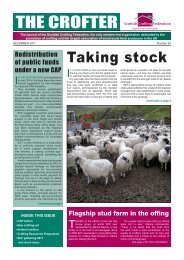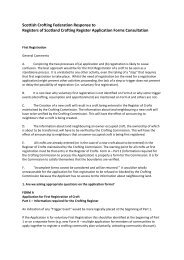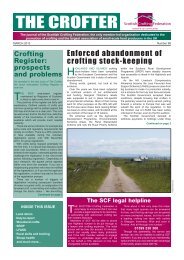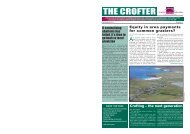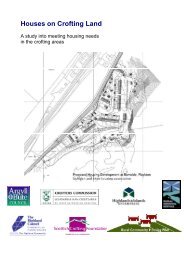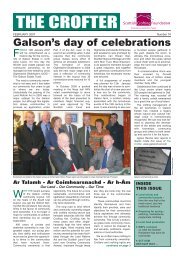Crofter 82 - Scottish Crofting Federation
Crofter 82 - Scottish Crofting Federation
Crofter 82 - Scottish Crofting Federation
Create successful ePaper yourself
Turn your PDF publications into a flip-book with our unique Google optimized e-Paper software.
Photo: David Whitaker from Skye Birds by R L MacMillan<br />
14<br />
THE CROFTER, MARCH 2009<br />
White-tailed sea eagle – tourist attraction or unacceptable predator?<br />
S<br />
NH in 2002 commissioned a report on<br />
the effect sea eagles had on Mull where<br />
there were also reports of lamb losses.<br />
One of the recommendations in the report was<br />
that all reintroductions should involve wide<br />
consultation among potential stakeholders.<br />
However, consultation was never carried out<br />
in Wester Ross.<br />
Farmers and crofters in Wester Ross have<br />
been losing lambs steadily since these birds<br />
were released. Four holdings on the Gairloch<br />
peninsula have suffered unprecedented<br />
losses, with over two hundred lambs lost to the<br />
sea eagle from May to September 2008. Over<br />
the last few years farmers and crofters have<br />
witnessed the destruction of their sheep flocks,<br />
with a 54% reduction in the lambs taken to the<br />
sales. Lambs have been found with puncture<br />
holes on their bodies, gasping their last breath<br />
after being dropped from the sky.<br />
SNH and RSPB claim that the white-tailed<br />
sea eagle will only take weak or unviable<br />
lambs, but there is evidence that they do kill<br />
strong lambs. Witnesses have seen them<br />
attacking ewes and even hinds and deer<br />
calves.<br />
The habitat these birds left 100 years ago<br />
when they where made extinct would have<br />
been very different from today, indeed you<br />
only have to go back thirty years to see the<br />
changes. Sea birds and ground nesting birds<br />
are dropping in numbers, rabbits are scarce<br />
and hares have never been seen for many a<br />
year, but he sea eagle cannot be blamed for<br />
the loss of all these creatures as they were in<br />
demise before their arrival. If there had been<br />
some consultation, many of these concerns<br />
could have been raised. I do feel that if there<br />
were plenty of birds, fish, rabbits and hares<br />
then probably our lambs would stand a better<br />
chance of being left alone – or would they?<br />
Lord Burton in 1984 expressed his concerns<br />
at encouraging the birds’ return saying in The<br />
Times: “As I understand it, the reason these<br />
birds became extinct in Scotland was because<br />
they were so destructive to sheep. If people are<br />
trying to make a living in the west Highlands<br />
it is very bad luck to have these thrust upon<br />
them.”<br />
Farmers and crofters for generations have<br />
been custodians of the land and have done<br />
a good job, making the most of the harsh<br />
environment. We know our hills and we have<br />
seen the changes. We know our sheep, and it<br />
is very distressing to see the possible end of<br />
this way of life and Highland culture.<br />
After a public meeting in Poolewe hall at<br />
the end of September SNH agreed to fund<br />
an independent enquiry. They will work along<br />
with local crofters and representatives of SNH,<br />
SCF, RSPB and SGRPID. A meeting was held<br />
at the end of November to find a way forward.<br />
There will be another meeting in February to<br />
finalise the timing of the study, hopefully at<br />
the end of May. There will be two holdings<br />
involved, one in the Gairloch area and one in<br />
Skye; this is yet to be decided.<br />
The <strong>Scottish</strong> Government has undertaken<br />
to protect crofting in fragile areas. However,<br />
along with electronic tagging, the end of the<br />
bull hire scheme, blue tongue and the modern<br />
trend for house farming, this is yet another nail<br />
in the coffin of farming and crofting in these<br />
remote areas. There has been a mass exodus<br />
of sheep in the north of Scotland. This problem<br />
has to be sorted out and taken seriously or it<br />
will only add to the acceleration of the exodus<br />
of sheep.<br />
Willie Fraser<br />
Evidence before compensation<br />
n a beautiful May afternoon in<br />
1908 my father, aged seven, and his<br />
Osister Maggie were sent over the hill to<br />
the local mill with the last of the bere and oats<br />
to be ground for flour.<br />
Subsistence living meant that schooling for<br />
older children in the family was an optional<br />
extra reserved for days when nothing else<br />
of importance was happening on the croft, to<br />
secure the survival of the whole family.<br />
They were dressed for the occasion with<br />
suitable clothing, equipment and food (a<br />
beremeal bannock each) for the round trip.<br />
Aunty Maggie had a beautiful red and maroon<br />
scarf she had knitted for herself and my dad<br />
took his favourite piece of driftwood as a staff.<br />
When they were deep into their journey, (in<br />
Shetland you can never be far from the sea)<br />
they noticed a large bird following them.<br />
Requiring a rest and some sustenance they<br />
sat down on a rock where suddenly this evil<br />
bird swooped down just missing them. My<br />
dad being the man (aged seven) held up his<br />
staff protecting his sister, screaming in the<br />
forlorn hope of attracting help. They believed<br />
to their dying day that the red scarf made this<br />
aggressive bird think it had found an injured<br />
prey which it could easily take back to its<br />
chicks.<br />
The screams of the children was heard by an<br />
elderly neighbour who happened to be in the<br />
hill doing the community lambing. She came<br />
to the rescue throwing her naturally coloured<br />
Shetland hap over Maggie’s head and staying<br />
with them until the nasty bird went on to look<br />
for another easy prey.<br />
The red scarf was thrown, the children went<br />
on to complete their task, the old neighbour<br />
went home and summoned a posse, knowing<br />
where the bird’s nest was. The best shot<br />
in the community was sent out first and he<br />
successfully shot the offending hen when she<br />
returned to feed her hungry chicks. The most<br />
agile youngster was roped and sent down the<br />
cliff to destroy the chicks in the nest.<br />
The old male hung around Shetland for<br />
a year or two but eventually it too died,<br />
thus ending the scourge of the sea eagle in<br />
Shetland.<br />
I would never encourage anyone to break<br />
the law, but it is a great concern to me that<br />
these beautiful but deadly birds are being<br />
introduced to Scotland again. My father, who<br />
laughed when telling about being torpedoed<br />
twice and having an oil tanker go on fire under<br />
him, had a terror in his eyes which I never saw<br />
at any other time in his life except when telling<br />
about their attack by this fearsome predator.<br />
There is also the story of the little girl lying<br />
asleep wrapped up in a Shetland hap (shawl<br />
– a very important item of attire for both young<br />
and old) at the side of the tattie rig, while the<br />
rest of the family were attending the crop. A sea<br />
eagle swooped down and snatched the child<br />
by the shawl and carried it to its eyrie in the<br />
sea cliffs. Once more the community gathered<br />
together sending a roped youngster down the<br />
cliff where the child was found unharmed. The<br />
lass was lucky as the chicks were obviously<br />
not hungry. The young man went to sea and<br />
after many trips around the world came home<br />
and again rescued the now young woman by<br />
marrying her and having a large family and<br />
there are many people believing they are<br />
descendants of this miracle union thus proving<br />
that the sea eagle is not all bad.<br />
Although there is as yet no evidence, I<br />
suggest crofters should refrain from using<br />
red or orange paint on their stock, if there is<br />
any possibility of attack from sea eagles, as<br />
this may indicate to this natural predator a<br />
weakness they can exploit. If we do all we<br />
can as crofters, we must insist on whoever<br />
authorised the realignment of the balance of<br />
nature to compensate us for any damage.<br />
Please let me know of any experiences you<br />
have had through unexplained losses and<br />
damage and what you believe the problem is.<br />
However before compensation can be sought<br />
tangible evidence must be presented.<br />
Norman Leask<br />
find us on-line at www.crofting.org




